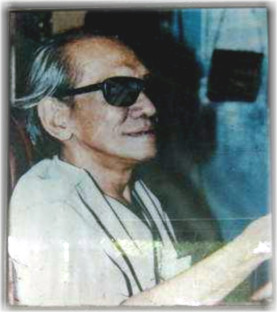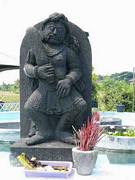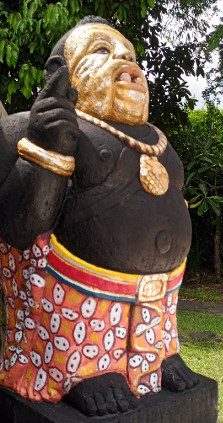A brief History of W. Hardjanta Pradjapangarsa’s leading up to the establishment of YAYASAN SAHASRA ADHI PURA or ONE THOUSAND TEMPLES ORGANIZATION
Bapak Hardjanta was born in 1926, the youngest son of a Surakarta palace (senchescal), bey steward (steward of lands owned by the palace.) In the early part of his life he did not follow any kind of spiritual teaching, although as a young child his “greatest enjoyment was to look at the shadow play and to hear the melodious voice of the dalang (wayang kulit puppet master)…. accompanied by Indonesian music.” Hardjanta tells how his “mind was filled with Eastern mythology” through these folk tales and myths. At the age of seven he attended Dutch Catholic school and was trained in western rationalistic thinking, and, in his own words, “became a one hundred percent materialist….rejecting all that was illogical to the materialistic concept of life,” “Knowledge is Power” became his device and he enthusiastically studied economics, sociology and revolutionary theories. However when World War II broke out and the Japanese occupied Indonesia replacing the Dutch, Bapak Hardjanta became disappointed and disillusioned with his revolutionary idols, who had become opportunists under the new regime. He realized “the weakness of man’s character and knowledge…..when confronted [with] the cruel, bare fact: The Japanese Samurai”. He left school and books and went to live in seclusion.
It was a visit from an old friend that helped Bapak Hardjanta see through his confusion and realize his destined path. During this visit, Bapak Hardjanta’s friend related to him “a brief description of [Bapak Hardjanta’s] experiences without the exception of the most personal parts of it.” Later, while the two of them were taking a walk together they were overtaken by a storm. The friend murmured “Wind and rain be still” and suddenly the storm calmed. With that encounter, Bapak Hardjanta realized the truth of the existence of supernatural forces. The “glasshouse of [his] materialistic theories was annihilated in a moment.” From that moment on he became an earnest seeker of the spiritual truths. He apprenticed himself to several gurus eventually entering seclusion on a small island in the Bengawan Solo River. It was here that he practiced ascetic exercises in the search for spiritual enlightenment.
During this period of seclusion, Bapak Hardjanta achieved a new understanding of divine knowledge. This was “Wisdom Philosophy”, which was based on the teachings of the “prophets and avatars of Indonesia”. He returned to the world to enrich it with his newly found knowledge, with plans for a Super Metaphysical Institute, which was to form the center of a world society. In 1953 these plans were forwarded to and approved by UNESCO. However, UNESCO required that the Institute be located in Paris, Bapak Hardjanta could not agree to this as his spiritual vision dictated that the Institute be established on ancient holy land, in Java. The plans were shelved.
By this time Bapak Hardjanta was making the transition from student to teacher. A significant event in his spiritual development at this time took place while on the island. One day a Wahyu (glowing light – translates as “godly spirit or force” – “divine radiance”) was seen to descend on Bapak Hardjanta. Immediately news of this event spread and the island was inundated with spiritual seekers. Bapak Hardjanta’s next endeavor was to found a Metaphysical Academy, based in Solo. The Academy was established and doctors, lawyers and engineers were among those who lectured on “the area where science touches metaphysics.” It was successful for a while until funds ran low and course fees were not being paid. Eventually the Academy folded.
Bapak Hardjanta was not deterred and continued to explore different avenues in an attempt to share his knowledge with the world. At an international level he communicated with many world leaders to share his plans. In Solo during the early 1960s, he set up a new venue, a tea shop, the “Warung Teko Chakra Bhavana” (the “World Wheel”), which provided a relaxed environment where those interested in the yogi’s spiritual message could find out a little more. He also set up a “pertapaan” (place for performing ascetic exercises) close to the palace in Solo in an area called Baluwarti. This provided a location where those with more than a passing interest could practice his yoga teachings.
In 1965, after the “Communistic rebellion failed, people became afraid of being accused of having some connection with Communism if they did not actively take part in religious activities. At that time [Bapak Hardjanta] was already a famous mystic, guiding many students from all over the country.” Confronted with the very repressive, dogmatic environment in the country, his students requested that he adopt one among the six legally recognized religions through which to express his mysticism. Previously operating both outside and above all religions, Bapak Hardjanta had no alternative at that time but to convert many of his followers into the Hindu Dharma religion. A new organization, “Sanataana Dharma Majapahit dan Pancasila” (Sadhar Mapan) was born. In Bapak Hardjanta’s words:
“Sadhar Mapan has been founded in view of our religious cultural need for expression of the indigenous religious heritage of our ancestors, a heritage which has come down to us from the times of the kingdom of Madjapahit in the form of customs and streams of belief which up till now have lacked a wadah – a “basin” – capable of containing and promoting them. Sadhar Mapan is such a vehicle. Sadhar Mapan also seeks to meet a social need to create world peace by cultivating the yoga system of introspection and the method of the “Sub-atomic scale of observation”, which form the metaphysical basis of the Sapta Gama Super Institute which I am promoting as a Center of a World Society.”
During the 1970s and 1980s westerners in search of traditional spiritual teachings from the East began to arrive in Solo. Some of these became yoga students at Sadhar Mapan in Baluwarti. Towards the end of the 1980s Bapak Hardjanta appointed one of his long time students as his assistant and directed newcomers to seek spiritual guidance under her. The number of western students grew and news of the ‘Meditation Center’ in Solo began to spread.
In 1997 Bapak Hardjanta left his physical body, passing on his legacy to a core group of yoga students. The group committed to continue practicing yoga and to realizing Hardjanta’s goal to establish a new spiritual center to the east of Bengawan Solo River. This center is already fully operational with private training in yogic philosophy and practice. As well, the fulfillment of Bapak Hardjanta’s spiritual vision to build “One Thousand miniature Temples” representing sacred sites throughout Indonesia and the world, has been set in motion. “Sahasra Adhi Pura – The One Thousand Temples Foundation”, was born and bought it’s first strip of land in the rice fields in Sukoharjo on the legendary sacred land of “Sonosewu,” several kilometers east of the Solo river. Now, five years on, the Foundation owns approximately 5000 square meters of land at Sonosewu. There is a Pendopo (Javanese style, open sided building), water meditation pools, places for yoga and meditation, and work has begun on the ARGO. temple complex. ARGO will comprise of the first fifty out of the eventual 1000 small-scale replica temples. Participation in and support for the project has come from people of many religions and nationalities. People from nearly every sector of Indonesian society and many countries around the world are included in the group of students and followers of the great, late Yogi.
Long term plans for Sonosewu include a library of translations of sacred books from Java, Indonesia and other cultures, and hospital for alternative and traditional healing and medicine.




